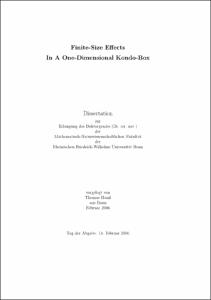Hand, Thomas: Finite-Size Effects In A One-Dimensional Kondo-Box. - Bonn, 2006. - Dissertation, Rheinische Friedrich-Wilhelms-Universität Bonn.
Online-Ausgabe in bonndoc: https://nbn-resolving.org/urn:nbn:de:hbz:5N-07530
Online-Ausgabe in bonndoc: https://nbn-resolving.org/urn:nbn:de:hbz:5N-07530
@phdthesis{handle:20.500.11811/2611,
urn: https://nbn-resolving.org/urn:nbn:de:hbz:5N-07530,
author = {{Thomas Hand}},
title = {Finite-Size Effects In A One-Dimensional Kondo-Box},
school = {Rheinische Friedrich-Wilhelms-Universität Bonn},
year = 2006,
note = {We study the correlation effects induced by a Kondo impurity embedded in a quantum box, using as a model a one-dimensional tight-binding band with a finite number of lattice sites which is coupled to an Anderson impurity. The model is solved by means of the density-matrix renormalization-group (DMRG) including the Lanczos method as well as the correction vector method. We examine systems with more than 500 sites retaining up to 2600 states. We define the Kondo temperature $T_K$ for the case of a discrete conduction electron density of states (level spacing $\Delta E$). The strength of the correlations, indicated by the weight of the Kondo resonance, $W$, is determined by the local conduction density of states at the impurity site, $x_0$. $W$ depends both on the symmetry of the conduction electron wave function at the Fermi edge, $\Psi_0(x)$, and on the impurity position $x_0$. We explain why the size of the Kondo peak fluctuates by changing the particle number $N$ between even and odd. We calculate the spin-correlations of the impurity spin and the spin of the conduction band and define a correlation length for a finite system, $l_k^{\rm num}$. We examine systems where the Kondo cloud --- measured by $l_k^{\rm num}$ --- is fully developed within the finite system. We show how the size of the Kondo peak corresponds to the size of the Kondo cloud.},
url = {https://hdl.handle.net/20.500.11811/2611}
}
urn: https://nbn-resolving.org/urn:nbn:de:hbz:5N-07530,
author = {{Thomas Hand}},
title = {Finite-Size Effects In A One-Dimensional Kondo-Box},
school = {Rheinische Friedrich-Wilhelms-Universität Bonn},
year = 2006,
note = {We study the correlation effects induced by a Kondo impurity embedded in a quantum box, using as a model a one-dimensional tight-binding band with a finite number of lattice sites which is coupled to an Anderson impurity. The model is solved by means of the density-matrix renormalization-group (DMRG) including the Lanczos method as well as the correction vector method. We examine systems with more than 500 sites retaining up to 2600 states. We define the Kondo temperature $T_K$ for the case of a discrete conduction electron density of states (level spacing $\Delta E$). The strength of the correlations, indicated by the weight of the Kondo resonance, $W$, is determined by the local conduction density of states at the impurity site, $x_0$. $W$ depends both on the symmetry of the conduction electron wave function at the Fermi edge, $\Psi_0(x)$, and on the impurity position $x_0$. We explain why the size of the Kondo peak fluctuates by changing the particle number $N$ between even and odd. We calculate the spin-correlations of the impurity spin and the spin of the conduction band and define a correlation length for a finite system, $l_k^{\rm num}$. We examine systems where the Kondo cloud --- measured by $l_k^{\rm num}$ --- is fully developed within the finite system. We show how the size of the Kondo peak corresponds to the size of the Kondo cloud.},
url = {https://hdl.handle.net/20.500.11811/2611}
}






